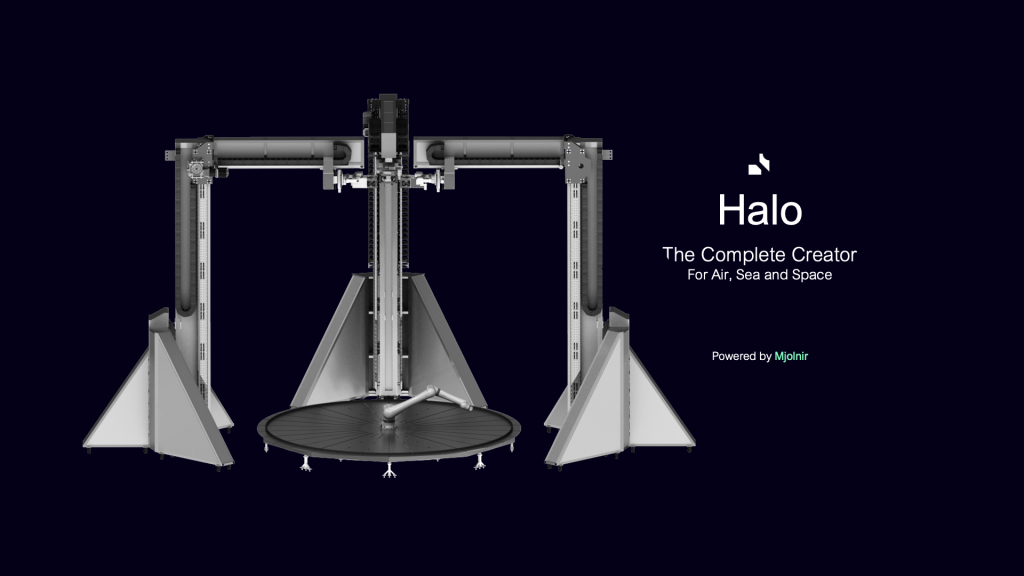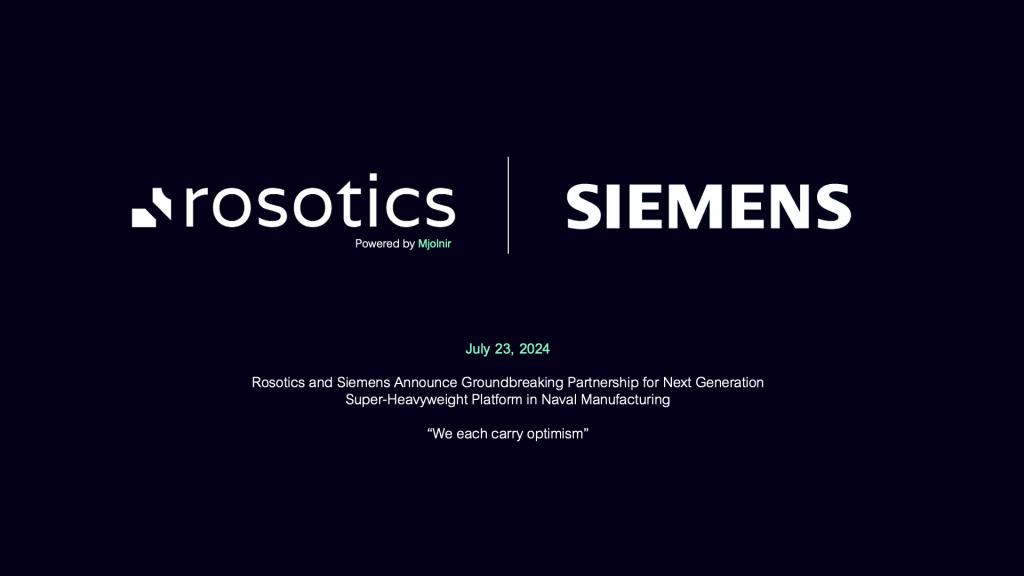Metal additive manufacturing company Rosotics has launched the Halo “supercreator,” a new large-format metal 3D printer targeting aerospace, naval, and defense applications.
The term “supercreator” was coined by the company. It denotes a machine that is in direct electrical interface with materials science using adaptive code.
The Halo employs a multi-phase electromagnetic process in place of more conventional lasers. The company’s HalOs software controls three electromagnetic printheads, called Mjolnir, to weld metal and produce near-net shape parts. Rosotics calls this process “the only induction-based head for additive manufacturing qualified for market.”
The new 3D printer is said to offer “unparalleled capabilities” across the entire production chain. These capabilities are reportedly distinct from other additive manufacturing processes, such as directed-energy deposition (DED), employed by the likes of Meltio and Relativity Space.
Rosotics followed this launch by announcing a new partnership with industrial manufacturing firm Siemens to develop a “next generation, super-heavyweight class” 3D printer for naval manufacturing. The company calls this initiative “the most challenging production effort ever yet attempted in naval engineering.”

Rosotics launches the new Halo “supercreator”
Named after Thor’s hammer, the Mjolnir printhead assembly can pre-heat, intricately fuse material at high feed rates, and conduct a prolonged thermal cycle before producing net-shape parts with smooth surfaces.
Each Halo system features three Mjolnir heads mounted on freestanding towers with multi-axis gimbals, all developed in-house by Rosotics. The HalOs control system is described as a form of ‘industrial intelligence,’ and is designed to understand and intervene during 3D printing to stabilize the deposition process.
Rosotics highlight several key benefits of this new technology, including significantly reduced power and infrastructure requirements. The Halo also boasts integrated post-processing and improved operational safety features.
The new system is designed for heavy industrial production applications and the repair and maintenance of existing structures. Halo’s “Reach” configuration offers a substantial 6-meter build envelope. It is also advertised as supporting complex geometries and post-print inspection and servicing tasks.
“Halo is not a 3D printer in the way you would think of it, as a tool,” explained Rosotics’ Founder Christian LaRosa. “It is built as the platform to make 3D printing sound like a primitive phrase. This is a system able to dominantly command metallurgical science, by understanding it.” According to LaRosa, this is historically significant, and represents a “profound means of creation unlike any that we have known before.”
At launch, the Halo offers broad compatibility with a range of metals and alloys, including those frequently used in aerospace and naval applications. Additionally, Rosotics has qualified material performance in aluminum, meeting tensile and yield strength standards. A “Controlled Atmosphere System Enclosure” can also be added to the Halo system. This produces an inert environment for more sensitive materials, like titanium.
The new 3D printers are assembled at Falcon Field Airport in Mesa, Arizona. According to Rosoitcs, the new platform facilitates environmentally sustainable production and energy efficiency. The Halo achieves a carbon footprint reduction per 500 kg of deposited mass of 86.74% compared to WAAM 3D printing.
Rosotics’ new 3D printer can be ordered now with an initial deposit of $5,000. Each system has a Manufacturer’s Suggested Retail Price (MSRP) of $950,000. Deliveries are set to begin in the United States and Europe on August 26, 2024.

Rosotics and Siemens partner to “revolutionize” naval manufacturing
Rosotics and Siemens have signed a Memorandum of Understanding (MoU) to develop a ‘next generation, super-heavyweight class’ manufacturing platform for naval and adjacent production applications.
The new platform will be supported by Sinumerik One, Siemens’ digital native CNC controller. This system offers digital twin capabilities, allowing manufacturers to create virtual representations of their development and machine processes. The controller can automate various machines used in the production process, such as milling and laser-cutting systems, speeding up manufacturing.
Rosotics claims that the results of this partnership will represent a significant milestone in manufacturing, “as profound as the first time steel was produced”. While more specific details are yet to be disclosed, it is understood that the new platform will be based on the Mjolnir print architecture. It will also reportedly be able to produce structures at an “exceptional scale” to address demand in heavy industrial sectors.
“We are thrilled to work with Siemens on creating this remarkable architecture; their shared commitments to sustainable manufacturing and deep capabilities in complex kinematics will be paramount drivers of this endeavor,” commented LaRosa. “Their demonstrated heritage in renewable energy speaks volumes to us and we do value it. We each carry optimism.”
A Siemens’ spokesperson added that the company is “excited to join forces with Rosotics in this groundbreaking endeavor.” They explained that integrating Sinumerik One with Rosotics’ additive manufacturing system will “create a platform of immense significance, capable of addressing the most complex production challenges in the naval industry.”

Developments in large-format metal 3D printing
Rosotics is not the only company developing large-format metal 3D printers for heavy industrial sectors.
Australian metal 3D printer manufacturer SPEE3D recently launched the TitanSPEE3D, a large-format cold spray 3D printer offering a substantial build volume and notable design freedom. Capable of producing parts with a diameter of 2.4 m and a height of 1 m, the system can fabricate parts weighing up to 2000 kg. It offers compatibility with a range of materials, including 6061 Aluminium, Aluminium Bronze, and 316 Stainless Steel.
Unveiled at the Large Scale Additive Action Team (LSAAT) meeting in Worcester, Massachusetts, TitanSPEE3D can 3D print large metal parts that typically require casting. This reportedly reduces production times from months to days.
Elsewhere, the Tekniker Technology Centre, a Basque Research and Technology Alliance (BRTA) member, unveiled its 3-meter-tall TITAN metal 3D printer.
Possessing a 6100 mm x 3100 mm x 3420 mm build volume, the DED system features a controlled atmosphere enclosure. This allows it to simulate various environmental conditions, making it particularly well-suited to aerospace and shipbuilding applications where components must endure extreme climates.
Want to help select the winners of the 2024 3D Printing Industry Awards? Join the Expert Committee today.
What does the future of 3D printing hold?
What near-term 3D printing trends have been highlighted by industry experts?
Subscribe to the 3D Printing Industry newsletter to keep up to date with the latest 3D printing news.
You can also follow us on Twitter, like our Facebook page, and subscribe to the 3D Printing Industry Youtube channel to access more exclusive content.
Featured image shows Rosotics’ new Halo 3D printer. Image via Rosotics.


